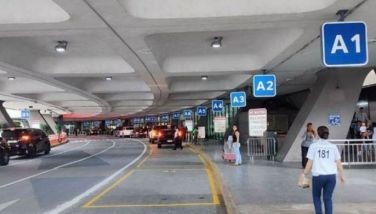The mass transport subsidy dilemma

January 20, 2006 | 12:00am
Our last column on the metropolis’ light railway transit system (When will the bleeding stop, 13 January 2006), elicited a number of reactions from our readers. Here are a couple that are worth reprinting. The first is by Roy Zosa. This is what he has to say:
"I fully agree with your views in (last week’s) column.
"In a BOT scheme for transport, the developer takes the market risk. Note the Skyway and NLEX. However, there is assurance from government that rate increases to cover cost increases not covered by the agreed escalator will not be artificially restricted.
"In the case of MRT 7, they are asking government to take the market risk, and asking for a fixed rental that permits a guaranteed return. They claim that the subsidy, difference between proposed fare and required economic fare, will be covered by real income that will be generated. You are absolutely correct to question as to what happens in case the assumed income does not take place.
"For the developers, they are getting two sets of income: the guaranteed lease rate and the real estate income. If they are confident of project merits and of their market studies, they should take the market risk and free the government from the guaranteed lease rental.
"Alternatively, government should bid out the scheme on the lowest rate formula approach with the real estate income, with all bidders to take the market risk.
"If it is government policy to subsidize mass transport, then it cannot be a BOT project."
Arnold B. Andaya, vice president at the Philippine Cut Flower Corp., shares the following thoughts:
"I would just like to comment on your column entitled When will the bleeding stop? I for one am a firm believer in the MRTs and the LRTs as a solution to our traffic problems here in Metro Manila. I also believe that it has done its job and is continuing to do its job providing the riding public a safe and fast means of transportation around the city.
"In fairness to the private companies that have invested in these projects, I feel these are some of the very few projects that we can say is worth all the centavos that the government is paying with our hard earned money. As you mentioned in your article, at least we know that in this one instance, the taxes we pay are directly going to helping our riding public get some breathing spell in the ever-increasing cost of living and working in the city.
"In looking at how the system works, one should be able to understand why all this is happening. I have only basic knowledge but it gave a better understanding of the situation facing investors here in our country especially for transportation and toll projects.
"Company A, B and C proposes an MRT project; of course at the end, to make a profit out of the project. They negotiate for a rate of return from government which gets eventually approved. This rate of return should have only one variable factor affecting its realization: the projected volume of people riding; this is, if the fare prices have already been agreed upon when the contract was signed.
"In our system, this is not the case. Even after the project is completed, the issue of how much the proponents will be allowed to charge the riding public is still up in the air pending deliberation of the different government departments tasked to evaluate the fare. This process includes public hearings that take in consideration public sentiments on the proposed fare. We all know what happens in the end; as you mentioned in your article, rate approval becomes a grandstanding venue of whoever administration is in power.
"This is also the same picture when you deal with toll projects.
"Now, the problem is that we want these first class facilities in place including nice roads, bridges, and world class airports but we do not want to pay for it. With the situation of the MRTs and LRTs, what the investors are simply saying is that if we build this project (will government) allow us to attain the rate of return that was approved when the contract was signed.
"If the government will only allow the operators to charge the riding public the real cost of riding them, then the government will not have to subsidize the fare price. What about the riding public? If they feel that is too expensive, they still have a choice to ride the other public transportation (facilities) available.
"At the end, I still believe that these projects are doing what it was built to do, to provide the riding public a safe and fast means of transportation around the city. It may not be cheap, but (it is) safe and fast.
"Just my two cents worth."
Here is good news for enthusiasts who consider poker as a highly competitive game of skill. The Philippine Poker Tour Million-Peso Hold’em Philippine Championship, the biggest NON-WAGER tournament to date, has been launched, and registration is now ongoing with the Poker Club of the Philippines.
There are two ways to participate in this search for the Philippine Hold’em Champion – one is by joining satellite tournaments and winning a guaranteed seat to the Main Event of the competition, and the other is to pay the tournament fee for an outright seat for the Main Event.
Those interested may visit www.PhilippinePokerTour.com <http://www.philippinepokertour.com/> or www.PokerClubof the Philippines.com or call the secretariat (c/o Cindy) at 817-9092 or 812-0153 for more details.
Should you wish to share any insights, write me at Link Edge, 4th Floor, 156 Valero Street, Salcedo Village, 1227 Makati City. Or e-mail me at [email protected] or at [email protected]. If you wish to view the previous columns, you may visit my website at http://bizlinks.linkedge.biz
"I fully agree with your views in (last week’s) column.
"In a BOT scheme for transport, the developer takes the market risk. Note the Skyway and NLEX. However, there is assurance from government that rate increases to cover cost increases not covered by the agreed escalator will not be artificially restricted.
"In the case of MRT 7, they are asking government to take the market risk, and asking for a fixed rental that permits a guaranteed return. They claim that the subsidy, difference between proposed fare and required economic fare, will be covered by real income that will be generated. You are absolutely correct to question as to what happens in case the assumed income does not take place.
"For the developers, they are getting two sets of income: the guaranteed lease rate and the real estate income. If they are confident of project merits and of their market studies, they should take the market risk and free the government from the guaranteed lease rental.
"Alternatively, government should bid out the scheme on the lowest rate formula approach with the real estate income, with all bidders to take the market risk.
"If it is government policy to subsidize mass transport, then it cannot be a BOT project."
"I would just like to comment on your column entitled When will the bleeding stop? I for one am a firm believer in the MRTs and the LRTs as a solution to our traffic problems here in Metro Manila. I also believe that it has done its job and is continuing to do its job providing the riding public a safe and fast means of transportation around the city.
"In fairness to the private companies that have invested in these projects, I feel these are some of the very few projects that we can say is worth all the centavos that the government is paying with our hard earned money. As you mentioned in your article, at least we know that in this one instance, the taxes we pay are directly going to helping our riding public get some breathing spell in the ever-increasing cost of living and working in the city.
"In looking at how the system works, one should be able to understand why all this is happening. I have only basic knowledge but it gave a better understanding of the situation facing investors here in our country especially for transportation and toll projects.
"Company A, B and C proposes an MRT project; of course at the end, to make a profit out of the project. They negotiate for a rate of return from government which gets eventually approved. This rate of return should have only one variable factor affecting its realization: the projected volume of people riding; this is, if the fare prices have already been agreed upon when the contract was signed.
"In our system, this is not the case. Even after the project is completed, the issue of how much the proponents will be allowed to charge the riding public is still up in the air pending deliberation of the different government departments tasked to evaluate the fare. This process includes public hearings that take in consideration public sentiments on the proposed fare. We all know what happens in the end; as you mentioned in your article, rate approval becomes a grandstanding venue of whoever administration is in power.
"This is also the same picture when you deal with toll projects.
"Now, the problem is that we want these first class facilities in place including nice roads, bridges, and world class airports but we do not want to pay for it. With the situation of the MRTs and LRTs, what the investors are simply saying is that if we build this project (will government) allow us to attain the rate of return that was approved when the contract was signed.
"If the government will only allow the operators to charge the riding public the real cost of riding them, then the government will not have to subsidize the fare price. What about the riding public? If they feel that is too expensive, they still have a choice to ride the other public transportation (facilities) available.
"At the end, I still believe that these projects are doing what it was built to do, to provide the riding public a safe and fast means of transportation around the city. It may not be cheap, but (it is) safe and fast.
"Just my two cents worth."
There are two ways to participate in this search for the Philippine Hold’em Champion – one is by joining satellite tournaments and winning a guaranteed seat to the Main Event of the competition, and the other is to pay the tournament fee for an outright seat for the Main Event.
Those interested may visit www.PhilippinePokerTour.com <http://www.philippinepokertour.com/> or www.PokerClubof the Philippines.com or call the secretariat (c/o Cindy) at 817-9092 or 812-0153 for more details.
Should you wish to share any insights, write me at Link Edge, 4th Floor, 156 Valero Street, Salcedo Village, 1227 Makati City. Or e-mail me at [email protected] or at [email protected]. If you wish to view the previous columns, you may visit my website at http://bizlinks.linkedge.biz
BrandSpace Articles
<
>
- Latest
- Trending
Trending
Latest






























